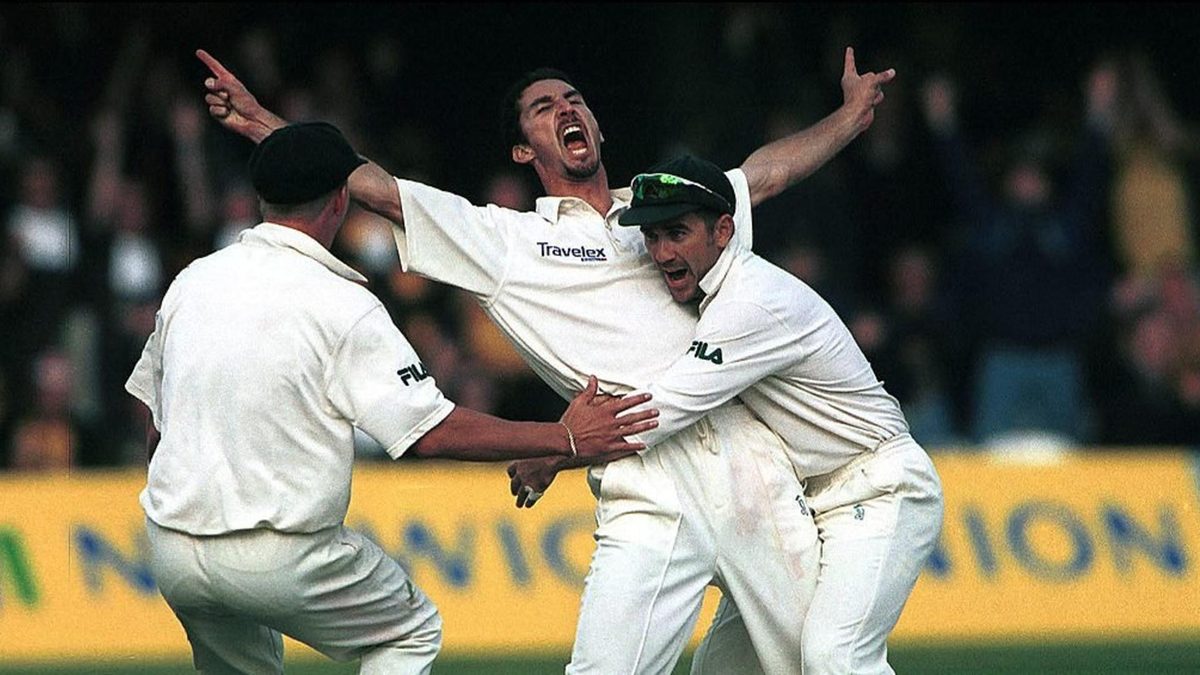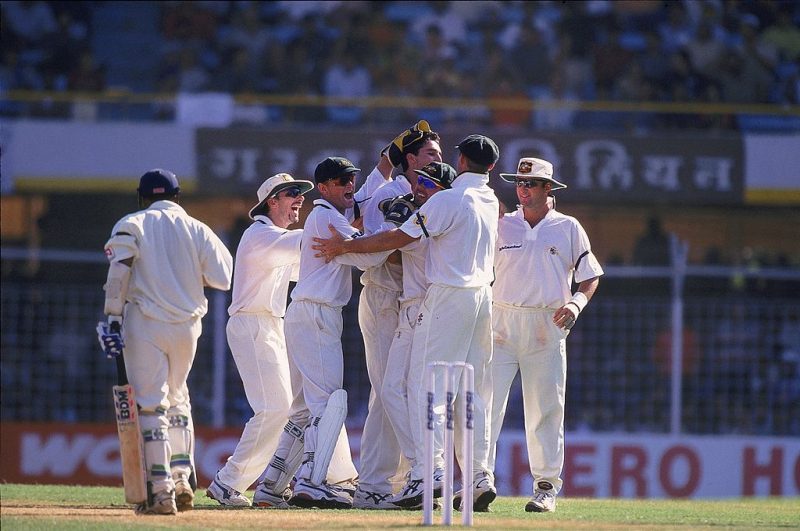
It was the night the third Test at Chennai had ended in a close two-wicket win for the home side. India had taken the series 2-1, after being thrashed in the first Test within three days, and Steve Waugh’s ambition of leading Australia to a series win in India had been thwarted. But not before a monumental physical and mental effort from one of Waugh’s favourite players, Jason Gillespie.
Jason Gillespie was one of the key performers in the Australian team that dominated England in the 2001 Ashes. It earned him a Wisden Cricketer of the Year award in the 2002 Wisden Almanack.
That day he almost dragged the Australians to victory with his second great spell of the match, both of which came towards the end of enervating days in the field under a fierce sun, and on a lifeless pitch. In the second innings, with India cruising to victory, Gillespie responded to the situation and – and to the roared encouragement of the pocket of Australian fans in the stand behind him – by digging as deep as cricketers are asked to go. He had Sachin Tendulkar caught off an edge, for the second time in the match, then Sourav Ganguly five balls later. The pressure was back on the Indians, but they scraped home in the end. Gillespie’s best was not quite enough to drag his side over the line.
That night he staggered out of a lift on to the Australians’ hotel floor, looking as if all he could do next was fall on his bed and sleep for days. The Test, like the first and second, had been a wonderful event – many rated the series the best three-match rubber ever – but even some journalists had suffered heat exhaustion watching from the open-air press box. No wonder Gillespie was a spent force. The next day it was announced that he was going home to recuperate, instead of staying for the one-day series.
No player on that tour deserved an early respite more than Gillespie, the 25-year-old South Australian fast bowler. Contrary to accepted wisdom, Australia had placed more faith in pace than spin, reasoning that the Indians never cope well with aggressive, high-class fast bowling. But with Brett Lee unavailable through injury, the burden of that game-plan fell on Glenn McGrath and Gillespie. Both accepted it superbly, taking 17 and 13 wickets respectively.
Yet, to those watching, Gillespie’s rewards had fallen short of his performances, repeating a worrying career pattern. And this after the injuries and accidents that had interrupted a Test career which began against West Indies at Sydney in November 1996, and revealed its full threat when he took seven for 37 against England at Headingley the following year.
 The efforts of Jason Gillespie weren’t enough to secure Australia a Test series win in India
The efforts of Jason Gillespie weren’t enough to secure Australia a Test series win in India
He missed most of the 1997/98 season with spinal stress fractures, and most of 1999/2000 with a broken leg and fractured wrist after that calamitous fielding collision with Steve Waugh at Kandy in September 1999. When a badly strained hamstring stopped him in November 2000, his whole career seemed threatened, not just his roles in the coming tours to India and England. Yet by the time he arrived in England six months later, he had formed a formidable new-ball pairing with McGrath.
Jason Neil Gillespie was born on April 19, 1975 in the bohemian inner Sydney suburb of Darlinghurst and, when ten, moved with his family to Adelaide. There, his natural athleticism and easy pace helped him progress quickly through the ranks, culminating in national U19 representation and a stint at the Cricket Academy.
In 2001, Gillespie’s Aboriginal heritage – through his paternal great-great-grandfather – became widely known when he was named captain of an Aboriginal team to play a Prime Minister’s XI in a match to mark an increased effort by the Australian Cricket Board to promote the game in the athletically gifted indigenous community.
 Jason Gillespie in his early days
Jason Gillespie in his early days
His early years in first-class cricket were notable for an honest approach to the hard work of fast bowling and a somewhat unconventional lifestyle. He wore a long ponytail, had a daughter named Sapphire and professed a liking for rock music of the more raucous variety. The ponytail eventually went in the interests of simplicity. His bowling continued to be refined, until he landed in England last summer with one of the more efficient, shorter run-ups in the game, and an ability to bowl with the seam so upright so often that he was able to move the ball either way on all surfaces.
In the first Test at Edgbaston, where he took a wicket with his first ball, he made a far-reaching impact when he produced a sharp lifter that smashed the little finger on Nasser Hussain’s left hand. The England captain missed the next two Tests, by which time Australia had retained the Ashes with three consecutive wins and Gillespie had taken 17 wickets at 20.47.
At Trent Bridge, after Shane Warne had turned and tormented England’s second-innings batting, Gillespie put them out of their misery with three wickets in 14 balls. His form faded in the last two Tests, but his influence on those early matches had severely damaged whatever hopes England had harboured of making a contest of the series.
 Jason Gillespie helped Australia win the 2001 Ashes in England
Jason Gillespie helped Australia win the 2001 Ashes in England
Mark Waugh, Australia’s brilliant second slip, said that Gillespie was the most difficult bowler to catch to because of his pace and lift off the pitch. But it was not just his speed that marked his performances against England in 2001. He combined high pace with such incisive accuracy and pronounced seam movement that there were times when he was unplayable.
At Trent Bridge, Gillespie reached 100 Test wickets, and his strike-rate of 48 at the end of the series was in the top bracket. Allan Donald’s, for example, was 46, McGrath’s 50. Steve Waugh has often said that, at his best, Gillespie is as good as any fast bowler Australia has produced. High praise from a captain who knows his cricket history.
Yet Waugh is not the only Australian to enjoy Gillespie’s success. The lanky fast bowler’s dry-humoured modesty and wholehearted approach have made him a most popular player. Moreover, behind his shy, often monosyllabic public utterances lies the sharp mind of a fiercely dedicated cricketer. His best is still ahead of him.
Jason Gillespie’s Test career continued until 2006. He took 259 wickets at 26.13 in 71 matches.








